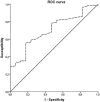HDL-c levels predict the presence of pleural effusion and the clinical outcome of community-acquired pneumonia
- PMID: 27652064
- PMCID: PMC5011465
- DOI: 10.1186/s40064-016-3145-x
HDL-c levels predict the presence of pleural effusion and the clinical outcome of community-acquired pneumonia
Abstract
Objectives: To investigate if HDL cholesterol (HDL-c) could be a biomarker of the degree of severity according to prognostic prediction scores in community-acquired pneumonia (CAP) or the development of clinical complications such as pleural effusion.
Methods: We included in a retrospective study 107 patients admitted to the hospital that fulfilled diagnostic criteria for CAP between the 30th October 2011 and 1st September 2012. HDL-c levels at admission, CAP prognosis scores (PSI and CURB65) and clinical outcomes were recorded for the study.
Results: Basal HDL-c levels were not statistically different according to prognostics scores neither PSI nor CURB-65. Significantly lower levels of HDL-c were also associated to the development of septic shock and admission to the intensive care unit. HDL-c were inversely correlated with acute phase reactants CRP (r = -0.585, P < 0.001), ESR (r = -0.477, P < 0.001), and leukocytes cell count (r = -0.254, P < 0.009). Patients with pleural effusion showed significant lower levels of HDL-c [28.9 (15.5) mg/dl vs. 44.6 (21.1) mg/dl]; P = 0.007. HDL-c is a good predictor of the presence of pleural effusion in multivariate analyses and using ROC analyses [AUC = 0.712 (0.591-0.834), P = 0.006]. HDL-c levels of 10 mg/dl showed a sensitivity of 97.6 % and a specificity of 82.4 % for the presence of pleural effusion.
Conclusion: Monitoring HDL-c in CAP is an useful serum marker of acute phase response, clinical outcome and the presence of pleural effusion.
Keywords: Community-acquired pneumonia; HDL; Pleural effusion.
Figures





References
LinkOut - more resources
Full Text Sources
Other Literature Sources
Research Materials
Miscellaneous

